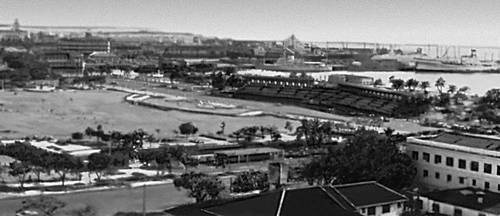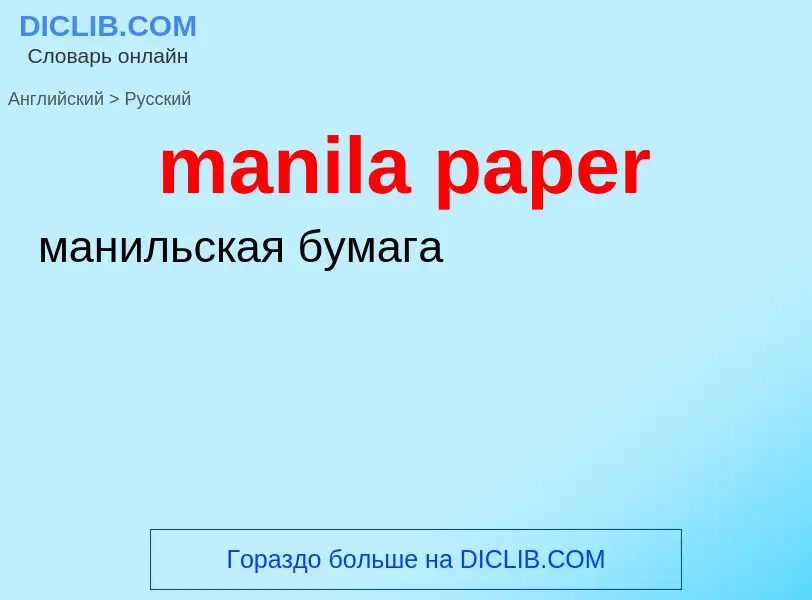Translation and analysis of words by ChatGPT artificial intelligence
On this page you can get a detailed analysis of a word or phrase, produced by the best artificial intelligence technology to date:
- how the word is used
- frequency of use
- it is used more often in oral or written speech
- word translation options
- usage examples (several phrases with translation)
- etymology
Manila paper - translation to russian
[mə'nilə]
общая лексика
манильский
синоним
Смотрите также
существительное
общая лексика
манильская пенька
банан текстильный
манильская сигара
манильская
обёрточная бумага
география
г. Манила
Смотрите также
Definition

Wikipedia

Manila paper is a relatively inexpensive type of paper, generally made through a less-refined process than other types of paper, and is typically made from semi-bleached wood fibers. It is just as strong as kraft paper but has better printing qualities, such as stronger pigment retention. Manila paper is buff-colored and the fibers of the paper are usually visible to the naked eye.
Manila is most commonly used for making file folders and envelopes, called Manila folders and Manila envelopes, respectively. Some fashion schools and people in the fashion industry use large rolls of Manila to create finalised clothing patterns. Because the paper is generally inexpensive, it is commonly given to children for making art.
Manila paper was originally made out of old Manila hemp ropes which were extensively used on ships, having replaced true hemp. The ropes were made from abacá or Musa textilis, which is grown in the Philippines; hence the association with Manila, its capital city. Abacá is an exceptionally strong fibre, nowadays used for special papers like tea bag tissue. It is also very expensive, being several times more expensive than woodpulp, hence the change to that fiber for what is still called Manilla—usually with two Ls. More recently new woodpulp has often been replaced with a high proportion of recycled fibers. True Manila hemp folders would have been much tougher and longer lasting than modern folders.


.jpg?width=200)



![San Ignacio Church]] in Intramuros San Ignacio Church]] in Intramuros](https://commons.wikimedia.org/wiki/Special:FilePath/Basketball in Intramuros.jpg?width=200)
.jpg?width=200)
![Feast of the Black Nazarene]] (''Traslacíon'') Feast of the Black Nazarene]] (''Traslacíon'')](https://commons.wikimedia.org/wiki/Special:FilePath/Black Nazarene procession.jpg?width=200)
![[[Divisoria]] is a popular flea market for locals and tourists. [[Divisoria]] is a popular flea market for locals and tourists.](https://commons.wikimedia.org/wiki/Special:FilePath/Divisoria Shopping.jpg?width=200)
![An illustration of [[Intramuros]] in the 1700s An illustration of [[Intramuros]] in the 1700s](https://commons.wikimedia.org/wiki/Special:FilePath/Intramuros, Manila 1700s.png?width=200)
![Binondo]], the central business district of the city of Manila. Binondo]], the central business district of the city of Manila.](https://commons.wikimedia.org/wiki/Special:FilePath/Intramuros-Binondo Bridge.jpg?width=200)
![[[Jones Bridge]] was redeveloped in 2019 to "restore" it to its near-original design using [[Beaux-Arts architecture]]. [[Jones Bridge]] was redeveloped in 2019 to "restore" it to its near-original design using [[Beaux-Arts architecture]].](https://commons.wikimedia.org/wiki/Special:FilePath/Jones Bridge ML PH (M. Onod pic) - Flickr.jpg?width=200)
![LRT Line 1]] LRT Line 1]]](https://commons.wikimedia.org/wiki/Special:FilePath/LRT-1 Blumentritt 2011.jpg?width=200)
![Saka]] 822 (c. 900). Saka]] 822 (c. 900).](https://commons.wikimedia.org/wiki/Special:FilePath/Laguna Copperplate Inscription.gif?width=200)
![Landbank Plaza, the headquarters of the [[Land Bank of the Philippines]] Landbank Plaza, the headquarters of the [[Land Bank of the Philippines]]](https://commons.wikimedia.org/wiki/Special:FilePath/Landbank Plaza (Malate, Manila; 01-01-2020).jpg?width=200)
(2018-02-22).jpg?width=200)
![The [[Luneta Hotel]], an example of [[French Renaissance architecture]] with Filipino stylized beaux art The [[Luneta Hotel]], an example of [[French Renaissance architecture]] with Filipino stylized beaux art](https://commons.wikimedia.org/wiki/Special:FilePath/Luneta Hotel.jpg?width=200)
![Plaza Moriones]] with the [[Manila Cathedral]] in the background. Plaza Moriones]] with the [[Manila Cathedral]] in the background.](https://commons.wikimedia.org/wiki/Special:FilePath/Manila Cathedral at Noon.jpg?width=200)
![[[Manila City Hall]], the seat of city government [[Manila City Hall]], the seat of city government](https://commons.wikimedia.org/wiki/Special:FilePath/Manila City Hall (Padre Burgos, Manila; 02-04-2021).jpg?width=200)
![The inaugural session of the 12th [[Manila City Council]] at the city hall. (2022). The inaugural session of the 12th [[Manila City Council]] at the city hall. (2022).](https://commons.wikimedia.org/wiki/Special:FilePath/Manila Mayor Lacuna in City Council inaugural session.jpg?width=200)
![Battle of Manila]] in 1945 Battle of Manila]] in 1945](https://commons.wikimedia.org/wiki/Special:FilePath/Manila Walled City Destruction May 1945.jpg?width=200)
![The National Museum of Natural History at Agrifina Circle, [[Rizal Park]] The National Museum of Natural History at Agrifina Circle, [[Rizal Park]]](https://commons.wikimedia.org/wiki/Special:FilePath/National Museum of Natural History (Manila) Facade - Front View.jpg?width=200)
![The campus of the [[Pamantasan ng Lungsod ng Maynila]] and Baluarte de San Diego in Intramuros The campus of the [[Pamantasan ng Lungsod ng Maynila]] and Baluarte de San Diego in Intramuros](https://commons.wikimedia.org/wiki/Special:FilePath/Pamantasan ng Lungsod ng Maynila.jpg?width=200)


![View of the [[Rizal Monument]] in [[Rizal Park]] View of the [[Rizal Monument]] in [[Rizal Park]]](https://commons.wikimedia.org/wiki/Special:FilePath/Rizal Park Front View.jpg?width=200)
![The [[Roxas Boulevard]] skyline along [[Manila Bay]]. The [[Roxas Boulevard]] skyline along [[Manila Bay]].](https://commons.wikimedia.org/wiki/Special:FilePath/Roxas Boulevard (D. Stanley pic) - Flickr.jpg?width=200)
![The façade of the [[Manila Metropolitan Theater]], designed by Filipino architect [[Juan M. Arellano]] The façade of the [[Manila Metropolitan Theater]], designed by Filipino architect [[Juan M. Arellano]]](https://commons.wikimedia.org/wiki/Special:FilePath/Santa Cruz Quiapo, Manila 12.jpg?width=200)
![Facade of the [[Supreme Court of the Philippines]]. Facade of the [[Supreme Court of the Philippines]].](https://commons.wikimedia.org/wiki/Special:FilePath/Supreme Court of the Philippines.jpg?width=200)
![A [[Toyota Vios]] of the Manila Police District A [[Toyota Vios]] of the Manila Police District](https://commons.wikimedia.org/wiki/Special:FilePath/Toyota Vios Philippine Police Car Manila City.jpg?width=200)
![TBF-1 Avenger]] dropping a bomb over the Pasig River in Manila targeting the dockyard, November 14, 1944 TBF-1 Avenger]] dropping a bomb over the Pasig River in Manila targeting the dockyard, November 14, 1944](https://commons.wikimedia.org/wiki/Special:FilePath/US Navy Photo 114-1 Bombing Manila 14 Nov 1944.png?width=200)
![Burnham Plan]] of Manila recommended improving the city's transit systems by creating diagonal arteries radiating from the new central civic district into areas at the outskirts of the city. Burnham Plan]] of Manila recommended improving the city's transit systems by creating diagonal arteries radiating from the new central civic district into areas at the outskirts of the city.](https://commons.wikimedia.org/wiki/Special:FilePath/BurnhamPlanOf-Manila.jpg?width=200)
![Neoclassical style]] architecture. Neoclassical style]] architecture.](https://commons.wikimedia.org/wiki/Special:FilePath/Central facade of the Legislative Building.jpg?width=200)
![American period]] American period]]](https://commons.wikimedia.org/wiki/Special:FilePath/Manilastreetcar.jpg?width=200)

![[[Manila Cathedral]] is the seat of [[Roman Catholic Archdiocese of Manila]]. [[Manila Cathedral]] is the seat of [[Roman Catholic Archdiocese of Manila]].](https://commons.wikimedia.org/wiki/Special:FilePath/02237jfManila Cathedral Intramuros Manila Palacio del Gobernador Landmarksfvf 12.jpg?width=200)
 Manila, Filipinas..jpg?width=200)
![[[Binondo Church]] serves the Roman Catholic Chinese community. [[Binondo Church]] serves the Roman Catholic Chinese community.](https://commons.wikimedia.org/wiki/Special:FilePath/Binondo, Manila San Nicolas Heritage Centre 47.jpg?width=200)
